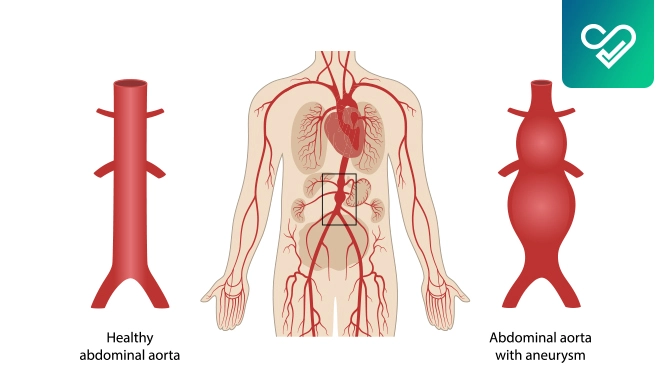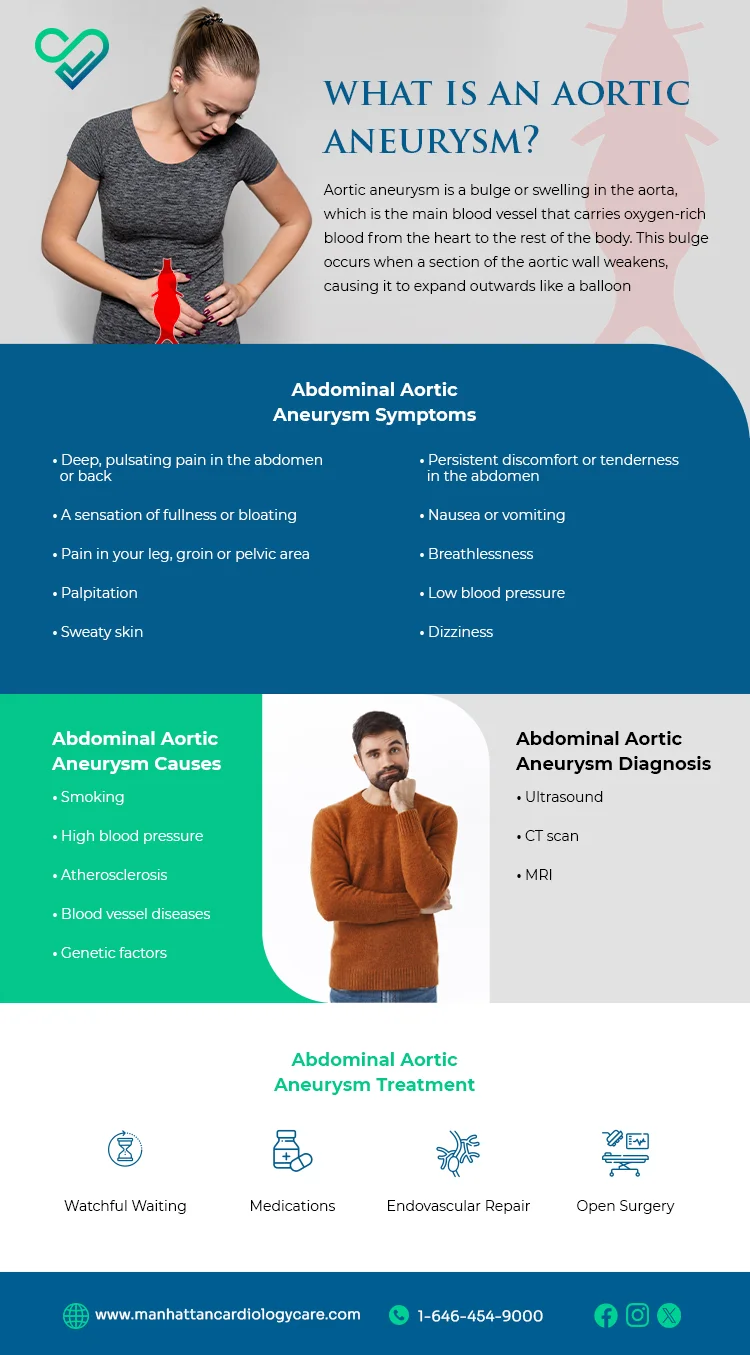Has there been a time when you felt a mysterious discomfort in your abdomen, maybe a constant sensation that something just isn’t quite right?
What if we tell you that this sensation in your abdomen could be a danger that is silently lurking inside your body? – This discomfort inducing condition could possibly be Abdominal Aortic Aneurysm.
In today’s blog, we will explore the world of abdominal aortic aneurysms, discovering the details behind this often undetected condition that affects thousands every year.
Table of contents
What is An Aortic Aneurysm?
Aortic aneurysm is a bulge or swelling in the aorta, which is the main blood vessel that carries oxygen-rich blood from the heart to the rest of the body. This bulge occurs when a section of the aortic wall weakens, causing it to expand outwards like a balloon.
Aortic aneurysms can occur in different parts of the aorta, including the abdomen (abdominal aortic aneurysm) and the chest (thoracic aortic aneurysm). If left untreated, the aortic aneurysm can rupture, which results in life-threatening internal bleeding.
How Common Are Abdominal Aortic Aneurysms?
Abdominal aortic aneurysms are much more common than we think – as it affects approximately 1 in every 50 people who’re over the age of 50.
Men are at a higher risk than women, especially those with a history of smoking, high blood pressure, or a family history of abdominal aortic aneurysm. Despite the massive prevalence of this condition, most individuals are unaware of their condition until it’s too late.
Abdominal Aortic Aneurysm Symptoms
One of the most hazardous aspects of abdominal aortic aneurysm is its tendency to remain asymptomatic until it gets to a critical point. However, some individuals may experience abdominal aortic aneurysm symptoms that include:
- Deep, pulsating pain in the abdomen or back
- Persistent discomfort or tenderness in the abdomen
- A sensation of fullness or bloating
- Nausea or vomiting
- Pain in your leg, groin or pelvic area
- Breathlessness
- Palpitation
- Low blood pressure
- Dizziness
- Sweaty skin
Abdominal Aortic Aneurysm Causes
Abdominal aortic aneurysm causes aren’t always clear, but there are several factors that can contribute to its development, including:
- Smoking: Tobacco use weakens the walls of the aorta, increasing the risk of aneurysm formation.
- High blood pressure: Chronic hypertension puts added strain on the aortic wall, making it more susceptible to bulging.
- Atherosclerosis: The buildup of fatty deposits in the arteries can damage the aortic wall and promote aneurysm formation.
- Blood vessel diseases: Diseases that can cause the blood vessels to become inflamed can lead to abdominal aortic aneurysm.
- Genetic factors: A family history of abdominal aortic aneurysm can significantly increase the risk of developing abdominal aortic aneurysm.
Abdominal Aortic Aneurysm Diagnosis
Abdominal aortic aneurysm diagnosis often requires physicians to carry out specialized imaging tests, such as:
- Ultrasound: This non-invasive imaging technique uses sound waves to create detailed images of the aorta, allowing physicians to identify abnormalities.
- CT scan: A computed tomography scan provides cross-sectional images of the abdomen, offering a more comprehensive view of the aorta and surrounding structures.
- MRI: Magnetic resonance imaging utilizes magnetic fields and radio waves to produce detailed images of the aorta, aiding in the diagnosis of abdominal aortic aneurysm.
Abdominal Aortic Aneurysm Treatment
Once diagnosed, abdominal aortic aneurysm treatment depends on its size, location, and the individual’s overall health.
Abdominal aortic aneurysm treatment options may include:
- Watchful waiting: For small aneurysms that aren’t causing symptoms, regular monitoring with imaging tests may be sufficient.
- Medications: Blood pressure-lowering medications can help reduce the risk of aneurysm growth and rupture.
- Endovascular repair: Minimally invasive procedures, such as endovascular stent grafting, can reinforce the weakened area of the aorta and prevent further expansion.
- Open surgery: In some cases, open surgical repair may be necessary to replace the damaged portion of the aorta with a synthetic graft.
When To See a Doctor?
If you’re experiencing any abdominal aortic aneurysm symptoms such as sudden or severe abdominal or back pain, you need to seek medical attention immediately.
Moreover, individuals with risk factors for abdominal aortic aneurysm, such as a family history of the condition or a history of smoking, should undergo routine screening to detect any abnormalities early on.
– Disclaimer –
This blog is for informational & educational purposes only, and does not intend to substitute any professional medical advice or consultation. For any health related concerns, please consult with your physician, or call 911.


